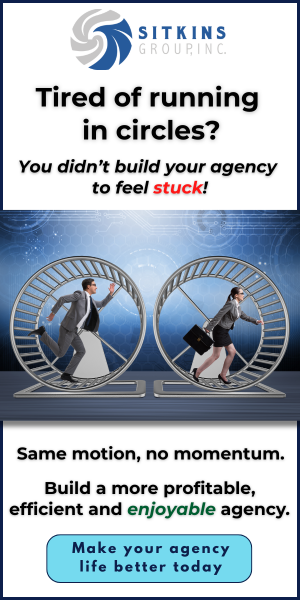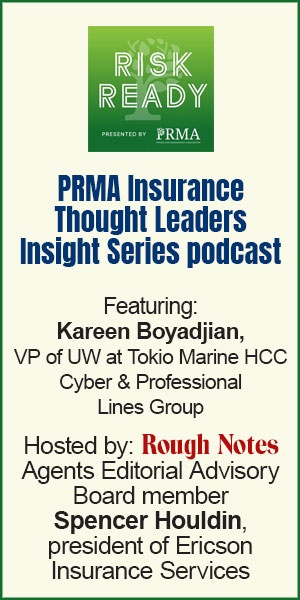Cultivating agency careers
by proper technology deployment
By Stephanie MacCormack
At The MacCormack Agency, my family-owned business in New Jersey, we’ve always been focused on taking care of our clients. We also recognize the importance of attracting and keeping qualified people to serve those clients. And to do that, we’ve had to adapt to cultural and operational changes along the way.
Our agency has a strong heritage and is truly a family affair; my dad and uncle have run the firm since 1965. My own path here wasn’t direct, having worked in Washington, D.C., as a research associate for the Armed Forces Radiobiology Research Institute before joining the family business as commercial lines manager.
Anyone new to the industry knows that working in the business requires a learning curve; that was the case for me. As I got more involved in the agency, learning every aspect from the ground up—filing claims, quoting commercial and personal lines, and even accounting—I could see where the insurance industry was heading.
We were using very old-school, paper-based systems, and that was going to hold us back. It became clear to me that we needed to make significant technological improvements to take care of our clients and ensure our long-term success.
Investing in our people
It wasn’t going to be easy, especially with having different generations involved, but I knew that we needed to evolve, not just to bring in more clients, but to create real career growth for our dedicated staff and build an agency where people genuinely wanted to work.
This meant devoting time and resources to our team and actively creating opportunities for them to grow.
One of the first things I wanted to do was shift our agency culture to be more sales oriented. We’ve always prided ourselves on customer service, and that will always be a priority. But I also wanted to empower my employees to explore sales if they were interested—to build their own books of business, market themselves, and expand their portfolios.
This required work on the part of leadership. As owners, my dad, my uncle, and I knew it was our responsibility to provide the tools and opportunities for everyone to grow. We believe that employees who are happy, valued, and see a future for themselves here will stay longer and do better work.
I also considered that if I was going to offer my staff these new avenues, their existing responsibilities still needed to be managed efficiently. Anyone in a small agency understands this challenge—a lot needs to get done with limited staff. This is where technology became the crucial enabler.
Technology as the catalyst for cultural change
I saw a huge opportunity to leverage technology in a way that went beyond simplifying our business and enhancing our customer service—I wanted to use it to create real career growth for our dedicated staff.
We started by focusing on our agency management system (AMS), envisioning it as the central point with the flexibility to connect with other applications. This has been a game-changer, saving my team time by reducing the need to enter the same information multiple times. Plus, our client portal now allows clients to make their own changes, which automatically updates the client accounts in our AMS. They can also pull their own information, saving even more time for our team.
Next, we tackled our marketing efforts, which were consuming a significant amount of our team’s time. Our old method of cold-calling just wasn’t producing results, and it was taking valuable time away from our staff. After a lot of research, we chose Applied Marketing Automation that would integrate seamlessly with Applied Epic. This has allowed us to use the information we already have to tailor campaigns for our existing customers, making sure they have the coverage they need.
For example, we can identify clients who might be missing crucial coverages like workers compensation or employee practices liability and reach out to them. This not only allows for more personalized touches but shows our clients that we’re still actively involved. This is much more effective than our old marketing process and it saves our team so much time.
Our marketing automation platform has also allowed us to provide prospects with educational materials, which helps establish us as knowledgeable and trustworthy advisors. It even gives me more peace of mind from an E&O (errors and omissions) standpoint, as we can proactively inform clients about emerging risks and offer relevant coverage. All these technological advancements have been vital for both operating and growing our agency.
Before automation, manually creating and running marketing campaigns took up a huge chunk of my staff’s day. They had the desire to learn new things and develop new skills, but these aspirations often got pushed aside by urgent marketing needs. By automating these processes, we’ve given our team back hours in their day, allowing them to concentrate on those bigger career goals—selling insurance, expanding their portfolios, and building their own client bases.
Anyone in a small agency understands [that] a lot needs to get
done with limited staff. This is where technology became the crucial enabler.
Embracing technology for long-term success
Looking back, the most exciting part of becoming a digital agency has been seeing the impact it’s had on our team. By reducing the day-to-day administrative burden through going paperless and automating campaigns, both my staff and I have been able to shift our focus to more strategic initiatives. Now, I can concentrate on the long-term vision for the agency and, more importantly, I can focus on the growth and development of my employees. I truly believe that technology is the future of the insurance industry. We have to embrace it if we want our staff and teams to be successful.
The author
Stephanie MacCormack is the commercial lines manager at The MacCormack Agency. Established in 1965 by Frank MacCormack Sr., The MacCormack Agency is a family-owned company that has grown into a full-service insurance agency. The agency currently serves the insurance needs of about 10,000 individuals and families and the insurance needs of more than 2,000 business concerns in the entire State of New Jersey.






